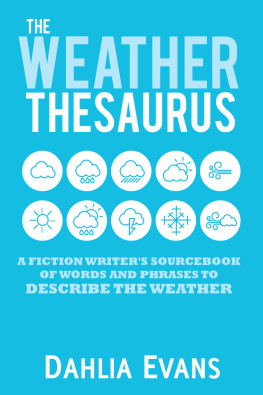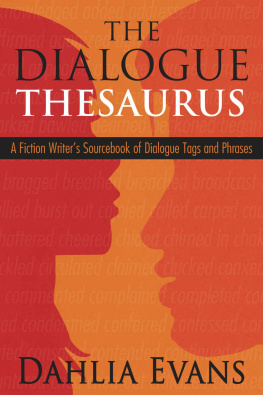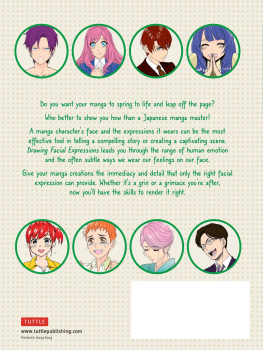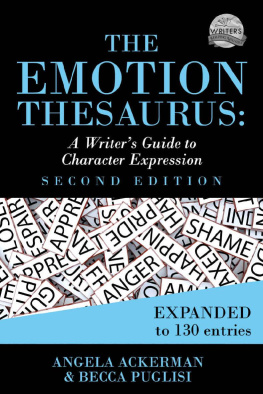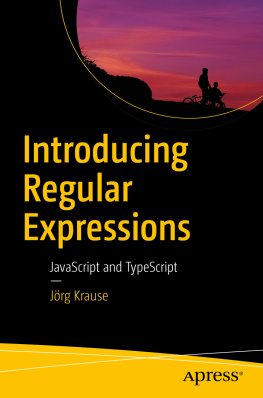Dahlia Evans - Character Expressions: A Fiction Writer’s Thesaurus of Facial Expressions
Here you can read online Dahlia Evans - Character Expressions: A Fiction Writer’s Thesaurus of Facial Expressions full text of the book (entire story) in english for free. Download pdf and epub, get meaning, cover and reviews about this ebook. year: 0, genre: Art. Description of the work, (preface) as well as reviews are available. Best literature library LitArk.com created for fans of good reading and offers a wide selection of genres:
Romance novel
Science fiction
Adventure
Detective
Science
History
Home and family
Prose
Art
Politics
Computer
Non-fiction
Religion
Business
Children
Humor
Choose a favorite category and find really read worthwhile books. Enjoy immersion in the world of imagination, feel the emotions of the characters or learn something new for yourself, make an fascinating discovery.

- Book:Character Expressions: A Fiction Writer’s Thesaurus of Facial Expressions
- Author:
- Genre:
- Year:0
- Rating:5 / 5
- Favourites:Add to favourites
- Your mark:
- 100
- 1
- 2
- 3
- 4
- 5
Character Expressions: A Fiction Writer’s Thesaurus of Facial Expressions: summary, description and annotation
We offer to read an annotation, description, summary or preface (depends on what the author of the book "Character Expressions: A Fiction Writer’s Thesaurus of Facial Expressions" wrote himself). If you haven't found the necessary information about the book — write in the comments, we will try to find it.
Dahlia Evans: author's other books
Who wrote Character Expressions: A Fiction Writer’s Thesaurus of Facial Expressions? Find out the surname, the name of the author of the book and a list of all author's works by series.
Character Expressions: A Fiction Writer’s Thesaurus of Facial Expressions — read online for free the complete book (whole text) full work
Below is the text of the book, divided by pages. System saving the place of the last page read, allows you to conveniently read the book "Character Expressions: A Fiction Writer’s Thesaurus of Facial Expressions" online for free, without having to search again every time where you left off. Put a bookmark, and you can go to the page where you finished reading at any time.
Font size:
Interval:
Bookmark:

Published By:
Satin Publishing
Copyright 2018 by Dahlia Evans. All Rights Reserved.
No part of this publication may be replicated, redistributed, or given away in any form without the prior written consent of the publisher.
"The Ultimate Thesaurus That Helps Fiction Writers Describe Characters With Ease!"
If you're like most writers, you get sick and tired of endlessly searching thesauri looking for that perfect word to describe your character's physical appearance or the way they move their body. Wouldn't it be easier to have a book that gives you all these words without the hassle? If you answered 'yes' , then this book is for you!
Dahlia Evans has compiled a thesaurus specifically aimed at describing a character's physical appearance and movement. This unique sourcebook is filled to the brim with words and phrases gathered from thousands of published novels. Now, you will have no problem conjuring up words and phrases like a magician, bringing your prose to life.
Inside You'll Discover:
# An exhaustive list of over 30,000 words and phrases describing each part of the body.
# 40 chapters, with each one including a list of adjectives, verbs, and noun phrases for that particular body part.
# Numerous example sentences showing many of these words in use.
# And best of all, words and phrases are sorted alphabetically, as well as by part of speech.
The Body Thesaurus is the ultimate fiction writer's companion; a resource that you'll want to keep close by for all your future writing projects.
The use of facial expressions to convey a character's emotional state is a vital part of fiction writing. These facial expressions usually take the form of descriptive phrases or clauses. And while on the surface they may appear simple, there are literally thousands of ways these descriptions can be rendered. And that good reader is where this thesaurus comes in.
Character Expressions is the result of hundreds of hours of corpus study. Using a selection of bestselling novels from popular genres, I was able to compile a body of useful words and phrases that can be used in all forms of popular fiction writing. These entries will give you an almost endless supply of descriptive recipes that will last a lifetime.
The Character Expressions thesaurus is divided into 18 chapters, with each one focusing on a specific facial expression. There is also an additional appendix that highlights the many ways to describe the word 'expression'.
Each chapter is broken up into two core sections. Section one is dedicated to the noun form of the entry, while section two focuses on the verb form . Within these sections there are subsections that show the many ways in which the word can be used.
Noun Form:
1. Noun Synonyms: This section lists similar words, as one might expect to find in a traditional thesaurus.
2. Adjectives: Numerous adjectives are given in alphabetical order. These adjectives appeared with the entry word in the corpus study. Therefore, they're what bestselling authors are using to describe the main entry word.
3. Noun + Prepositional Phrases: These entries include the noun form followed by a prepositional phrase (also called an adjectival prepositional phrase ). As the name suggests, these phrases describe the noun. You will find some chapters have more listings than others. This is based on the corpus; some expressions are more popular than others in their use of adjectival prepositional phrases. In practice, these entries are used instead of Adj + Noun. For example, instead of writing: 'An uncertain frown,' you could use: 'A frown of uncertainty.'
4. Noun Phrases: This section lists noun phrases. In practice, these entries are typically used as a replacement for the single noun. For example, instead of writing: 'A frown crossed her forehead,' you could write: 'The ghost of a frown crossed her forehead.'
5. Verbs - Word as Subject: This section and the next are sorted by facial feature. There is also a standalone verb section in some chapters. Use this section when you want to describe the noun as the subject of a sentence.
6. Verbs - Word as Object: This section is used when you want to describe the main noun as an object of a verb, or the object of a preposition.
Note: An asterisk indicates that a particular entry doesn't fit 100%. That could be:
a) It isn't totally intransitive (for standalone).
b) It is used in the passive voice, or a passive way.
c) It should be used in a descriptive sense; For instance, using linking verbs, such as the forms of be (is/was/are etc.).
7. Noun Usage Examples: These sentences include examples which illustrate the use of the noun form, adjectives, adjectival prepositional phrases, and noun phrases.
Verb Form:
1. Verb Synonyms: Just like the noun synonyms, these verb synonyms are what you would typically find in a standard thesaurus.
2. Adverbs: These adverbs were found associated with the main verb during the corpus study. An asterisk signifies that the adverb almost always precedes the verb. All unmarked adverbs are typically used both before and after the verb.
3. Adverbials: These include adverbials of emotion, feeling, mental state, appearance, environment, and response. An asterisk is typically used to differentiate appearance types or other non-emotion types from the rest. Most entries are of the emotion or feeling variety.
4. Verb Usage Examples: These sentences include examples which illustrate the use of verbs, participle, gerunds, adverbs, and adverbials.
The best way to illustrate the use of the thesaurus is to give you an example.
Example: You have a female character who is feeling embarrassed. You want to convey this using a flush or blush.
Go to Chapter 2: Flush/Blush and dig around until you find a phrase or clause that sparks an idea in your mind.
Now, you could just write something like:
Samantha flushed in embarrassment.
But, you may also want to be more visual, like so:
A flush of palest rose bloomed across Samantha's cheekbones.
Ultimately, it's up to you. In most cases, context and style will be the deciding factor. Another important factor is the type of genre you're writing. For example, thrillers tend to be less descriptive than romances. In any case, you will find exactly what you need in this thesaurus which has been compiled using all popular genres.
Also, be sure to take some time to just read through each chapter as well as the appendix. This exercise will help hone your ability as a wordsmith.
Font size:
Interval:
Bookmark:
Similar books «Character Expressions: A Fiction Writer’s Thesaurus of Facial Expressions»
Look at similar books to Character Expressions: A Fiction Writer’s Thesaurus of Facial Expressions. We have selected literature similar in name and meaning in the hope of providing readers with more options to find new, interesting, not yet read works.
Discussion, reviews of the book Character Expressions: A Fiction Writer’s Thesaurus of Facial Expressions and just readers' own opinions. Leave your comments, write what you think about the work, its meaning or the main characters. Specify what exactly you liked and what you didn't like, and why you think so.


